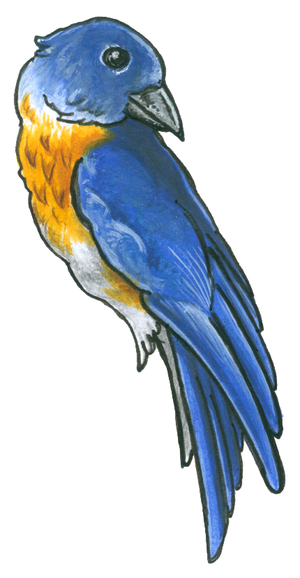Martlet: Difference between revisions
imported>Alexander Liptak No edit summary |
imported>Alexander Liptak No edit summary |
||
| Line 5: | Line 5: | ||
The earliest known depiction of a ''merlette'' comes to us c. 1185 in the coat of arms of the Mello family of Normandy, and soon after in the canting arms of families such as Merlot and Merloz. This gives weight to the notion that the heraldic bird originally intended to depict a blackbird, known as ''merle'' in the French language. However, from the 14th century onwards the term ''merlette'' appears to be employed as a generic term for any small bird, appearing in the canting arms of families such as Oisery, Oisy and Loiseau, and is no longer representative of any specific species of bird. During this period, the depictions vary between the footed and footless ''merlette''; from the late 15th century onward the bird is more frequently depicted without a beak in emblazonings. Also in the 15th century, confusion between the ''merlette'' and the ''canette'', or duckling, seem to arise, giving the ''merlette'' the appearance of a duckiling without bill or feet. | The earliest known depiction of a ''merlette'' comes to us c. 1185 in the coat of arms of the Mello family of Normandy, and soon after in the canting arms of families such as Merlot and Merloz. This gives weight to the notion that the heraldic bird originally intended to depict a blackbird, known as ''merle'' in the French language. However, from the 14th century onwards the term ''merlette'' appears to be employed as a generic term for any small bird, appearing in the canting arms of families such as Oisery, Oisy and Loiseau, and is no longer representative of any specific species of bird. During this period, the depictions vary between the footed and footless ''merlette''; from the late 15th century onward the bird is more frequently depicted without a beak in emblazonings. Also in the 15th century, confusion between the ''merlette'' and the ''canette'', or duckling, seem to arise, giving the ''merlette'' the appearance of a duckiling without bill or feet. | ||
Coincidentally, the French ''merlette'' was confused with the martlet in England, the common folk name for a [[swift]] at the time. The earliest examples of the martlet in English heraldry show the bird to be footed, but by the end of the 13th century the footless depictions become more frequent, and the bird is even | Coincidentally, the French ''merlette'' was confused with the martlet in England, the common folk name for a [[swift]] at the time. The earliest examples of the martlet in English heraldry show the bird to be footed, but by the end of the 13th century the footless depictions become more frequent, and the bird is even found without a beak in some examples. Several instances of footed martlets do appear since then, as the custom of the footless martlet has not always been adhered to; the martlets of John de Bassingbourne are without legs, those of Furnival are with legs, Robert Muschet depicts sparrow-hawks without feet in his arms and a 13th century panel in Westminster of Edward the Confessor's arms show the martlets as doves with feet. | ||
Revision as of 12:46, 1 December 2012
The martlet, alternately spelled merlette in French sources, is an imagined bird found primarily in English, French and German heraldry; English custom depicts a bird similar to a sparrow or house martin without feet, the French custom renders the merlette as a duckling without feet or bill and German tradition treats the bird similiar to a lark.
The earliest known depiction of a merlette comes to us c. 1185 in the coat of arms of the Mello family of Normandy, and soon after in the canting arms of families such as Merlot and Merloz. This gives weight to the notion that the heraldic bird originally intended to depict a blackbird, known as merle in the French language. However, from the 14th century onwards the term merlette appears to be employed as a generic term for any small bird, appearing in the canting arms of families such as Oisery, Oisy and Loiseau, and is no longer representative of any specific species of bird. During this period, the depictions vary between the footed and footless merlette; from the late 15th century onward the bird is more frequently depicted without a beak in emblazonings. Also in the 15th century, confusion between the merlette and the canette, or duckling, seem to arise, giving the merlette the appearance of a duckiling without bill or feet.
Coincidentally, the French merlette was confused with the martlet in England, the common folk name for a swift at the time. The earliest examples of the martlet in English heraldry show the bird to be footed, but by the end of the 13th century the footless depictions become more frequent, and the bird is even found without a beak in some examples. Several instances of footed martlets do appear since then, as the custom of the footless martlet has not always been adhered to; the martlets of John de Bassingbourne are without legs, those of Furnival are with legs, Robert Muschet depicts sparrow-hawks without feet in his arms and a 13th century panel in Westminster of Edward the Confessor's arms show the martlets as doves with feet.
